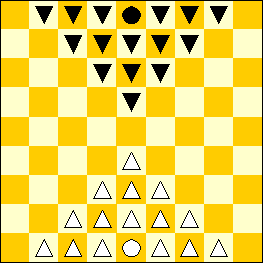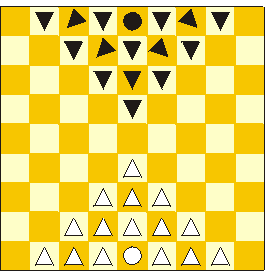Omega Chess
Gabriel Vicente Maura from Puerto Rico invented this game in 1974. Vicente Maura is better known for his invention of Modern Chess. In his book Evolucion del Ajedrez, he describes many chess variants. While Modern Chess received much emphasis in the book, he also described this other invention of himself.
The game was first played June 2, 1974, by mr. Jose Luis Escario and mr. Bonifacio Pedraz Cabeza. It took two hours and was played in Arganda, Spain. The game has been played in Spain, Puerto Rico, and Mexico.
Rules
The game is played by two players on a nine by nine board. Each player has 27 pieces: one Omega, and 26 Delta's. The Omega's start the game at e1 (for white) and e9 (for black). The Delta's are setup at the remaining 26 squares of the first three rows of each players side, as in the following diagram.

As one can see, a Delta is a triangle. It is of importance whether the triangle points to a corner of a square, or to a side of a square, and to which corner or side it points. Before the game start, players may point the Delta's in the directions as they wish. (So, the setup shown in the diagram may be changed by pointing some or all delta's in different directions.) Then, it is decided by chance which player starts with the first move.
Movement of the pieces
The Omega moves as the king of usual chess: one square in an arbitrary direction. Also, just as the chess-king, the Omega may not be placed into check.
A Delta moves like a rook or bishop in the direction it points. After a move (both when the move took a delta of an opponent, and when it was a move without taking), the direction of a Delta may be changed. Also, a player may change the direction of a Delta instead of making a normal move.
There is one restriction on taking other Delta's: one may not take a Delta whose direction is pointing in exactly the opposite direction, i.e., Delta's that point towards each other cannot take each other. It is allowed to take ones own Delta's with a Delta, and for this, the same restriction is applied.
Winning the game
A player can win the game in two ways: by mating the opponent's Omega, and by moving his Omega to the square the Omega of the opponent started the game on, i.e., white can win by moving his Omega to e9, and black can win by moving his Omega to e1.
Check and stalemate are as in usual chess, but note that a player cannot be stalemated when he has at least one Delta as a move that changes the direction of a Delta without moving it is then always possible.
Comments
Maura comments that draws are rare, and that the game can quickly be learned and is a nice pastime for chess and Modern chess players.
Carlos Cetina suggests a different setup, inspired by his game Coherent chess.

As one can see in the diagram, white has an Omega on e1, and Delta's on b1, c1, c2, d1, d2, d3, e2, e3, e4, f1, f2, f3, g1, g2, h1, while the setup of black is symmetric.
This setup has less Delta's, which may cause a faster game.
Sample game
White: Carlos Cetina Villahermosa, Mexico Black: Felix Miranda April 23, 1998As starting position, the setup of Cetina, as given above was taken, with the following orientation of the delta's:
White: all the deltas aiming towards the north.
Black: c9(SW), d8(SW), f8(SE), g9(SE); the remainder deltas aiming
towards the south.

NOTE: Deltas direction changes are described by indicating between parenthesis after each move the new direction, using the following annotation: N=north, E=east, S=south, W=west, NE=northeast, NW=northwest, SE=southeast, SW=southwest. The orientation is always for both players that of White's viewpoint. If a delta doesn't change its direction, then after the move there is no indication.
1.h1-h3 g9-i7 (SW) 2.d2 (NE) d8-a5 (SE) 3.f2 (NW) f8-i5 (SW) 4.e3 (NE) c9-a7 (SE) 5.e3-h6 (NW)+ f9-f8 (SE) 6.g1 (NW) e7 (SE) 7.d1 (NE) e7-i3 (SW) 8.g1 (NE) a7xf2 (S) 9.e2-e3 (SE) h9xh6 (SW) 10.e3xf2 (NE) h6-e3 (S)+ 11.d1-e2 (N) f8 (SW) 12.e1-d1 f8-a3 (SE) 13.d2xe3 d9-d8 (SW) 14.h3-h9 (W)+ e9-f8 15.h9xb9 (SE) d8-b6 (S) 16.b9xc8 e8 (SW) 17.c8xd7 (NE) a5 (E) 18.c2-c8 (E) a5-c5 (S) 19.c8xe8+ f8-e7 20.e8 (S)+ e7-d8 21.e8xe6 (NE) a3xc1 (E)+ 22.d1-d2 c1 (NE)+ 23.d2-d1 c1xe3 (S) 24.e6xf7 (W) b6-b3 25.d7-f9 (W)+ d8-c8 26.e4-e8 (W) mate
Written by Hans Bodlaender and Carlos Cetina. Carlos invites readers to play a game of Omega Chess with him: contact him by email at (email removed contact us for address) s.ujat.mx.
WWW page created: May 6, 1998. Last modified: May 11, 1998.
